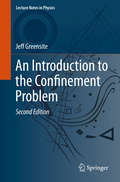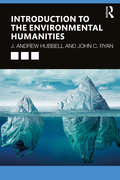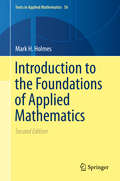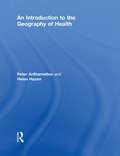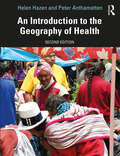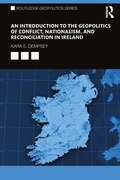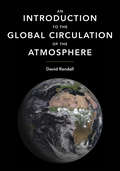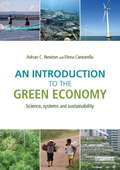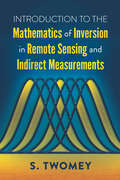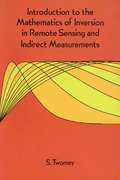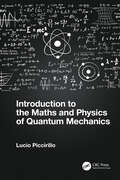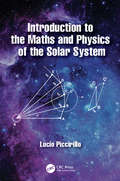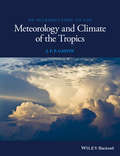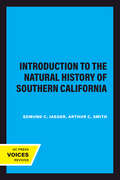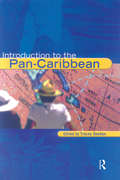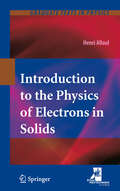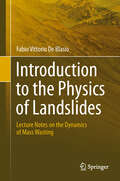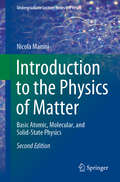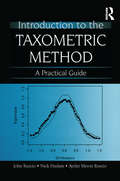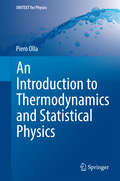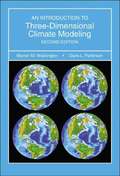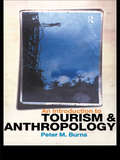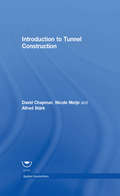- Table View
- List View
An Introduction to the Confinement Problem (Lecture Notes in Physics #972)
by Jeff GreensiteThis book addresses the confinement problem, which concerns the behavior of non-abelian gauge theories, and the force which is mediated by gauge fields, at large distances. The word “confinement” in the context of hadronic physics originally referred to the fact that quarks and gluons appear to be trapped inside mesons and baryons, from which they cannot escape. There are other, and possibly deeper meanings that can be attached to the term, and these will be explored in this book. Although the confinement problem is far from solved, much is now known about the general features of the confining force, and there are a number of very well motivated theories of confinement which are under active investigation. This volume gives a both pedagogical and concise introduction and overview of the main ideas in this field, their attractive features, and, as appropriate, their shortcomings. This second edition summarizes some of the developments in this area which have occurred since the first edition of this book appeared in 2011. These include new results in the caloron/dyon picture of confinement, in functional approaches, and in studies of the Yang-Mills vacuum wave functional. Special attention, in two new chapters, is given to recent numerical investigations of the center vortex theory, and to the varieties of confinement which may exist in gauge-Higgs theories. Reviews of the first edition: “This is indeed a very good book. I enjoyed reading it and… I learned a lot from it.… It is definitely a research book that provides readers with a guide to the most updated confinement models.” (Giuseppe Nardelli, Mathematical Reviews, Issue 2012 d) “The book is beautifully produced with special emphasis on the relevance of center symmetry and lattice formulation as well as an introduction to current research on confinement.” (Paninjukunnath Achuthan, Zentralblatt MATH, Vol. 1217, 2011)
Introduction to the Environmental Humanities
by J. Andrew Hubbell John C. RyanIn an era of climate change, deforestation, melting ice caps, poisoned environments, and species loss, many people are turning to the power of the arts and humanities for sustainable solutions to global ecological problems. Introduction to the Environmental Humanities offers a practical and accessible guide to this dynamic and interdisciplinary field. This book provides an overview of the Environmental Humanities’ evolution from the activist movements of the early and mid-twentieth century to more recent debates over climate change, sustainability, energy policy, and habitat degradation in the Anthropocene era. The text introduces readers to seminal writings, artworks, campaigns, and movements while demystifying important terms such as the Anthropocene, environmental justice, nature, ecosystem, ecology, posthuman, and non-human. Emerging theoretical areas such as critical animal and plant studies, gender and queer studies, Indigenous studies, and energy studies are also presented. Organized by discipline, the book explores the role that the arts and humanities play in the future of the planet. Including case studies, discussion questions, annotated bibliographies, and links to online resources, this book offers a comprehensive and engaging overview of the Environmental Humanities for introductory readers. For more advanced readers, it serves as a foundation for future study, projects, or professional development.
Introduction to the Foundations of Applied Mathematics (Texts in Applied Mathematics #56)
by Mark H. HolmesThe objective of this textbook is the construction, analysis, and interpretation of mathematical models to help us understand the world we live in. Rather than follow a case study approach it develops the mathematical and physical ideas that are fundamental in understanding contemporary problems in science and engineering. Science evolves, and this means that the problems of current interest continually change. What does not change as quickly is the approach used to derive the relevant mathematical models, and the methods used to analyze the models. Consequently, this book is written in such a way as to establish the mathematical ideas underlying model development independently of a specific application. This does not mean applications are not considered, they are, and connections with experiment are a staple of this book. The book, as well as the individual chapters, is written in such a way that the material becomes more sophisticated as you progress. This provides some flexibility in how the book is used, allowing consideration for the breadth and depth of the material covered. Moreover, there are a wide spectrum of exercises and detailed illustrations that significantly enrich the material. Students and researchers interested in mathematical modelling in mathematics, physics, engineering and the applied sciences will find this text useful.The material, and topics, have been updated to include recent developments in mathematical modeling. The exercises have also been expanded to include these changes, as well as enhance those from the first edition.Review of first edition:"The goal of this book is to introduce the mathematical tools needed for analyzing and deriving mathematical models. … Holmes is able to integrate the theory with application in a very nice way providing an excellent book on applied mathematics. … One of the best features of the book is the abundant number of exercises found at the end of each chapter. … I think this is a great book, and I recommend it for scholarly purposes by students, teachers, and researchers." Joe Latulippe, The Mathematical Association of America, December, 2009
An Introduction to the Geography of Health
by Peter Anthamatten Helen HazenHealth issues such as the emergence of infectious diseases, the potential influence of global warming on human health, and the escalating strain of increasing longevity and chronic conditions on healthcare systems are of growing importance in an increasingly peopled and interconnected world. A geographic approach to the study of health offers a critical perspective to these issues, considering how changing relationships between people and their environments influence human health. An Introduction to the Geography of Health provides an accessible introduction to this rapidly growing field, covering theoretical and methodological background. The text is divided into three sections which consider distinct approaches and techniques related to health geographies. Section one introduces ecological approaches, with a focus on how natural and built environments affect human health. For instance, how have irrigation projects influenced the spread of water-borne diseases? How can modern healthcare settings, such as hospitals, affect the spread and evolution of pathogens? Section two discusses social aspects of health and healthcare, considering health as not merely a biological interaction between a pathogen and human host, but as a process that is situated among social factors which ultimately drive who suffers from what, and where disease occurs. Section three then considers spatial techniques and approaches to exploring health, giving special focus to the growing role of cartography and geographic information systems (GIS) in the study of health. This clearly written text contains a range of pedagogical features including a wealth of global case studies, discussion questions and suggestions for further reading at the end of each chapter, a colour plate section and over eighty diagrams and figures. The accompanying website also provides presentations, exercises, further resources, and tables and figures. This book is an essential introductory text for undergraduate students studying Geography, Health and Social Studies.
An Introduction to the Geography of Health
by Peter Anthamatten Helen HazenIn the second edition of An Introduction to the Geography of Health, Hazen and Anthamatten explore the ways in which geographic ideas and approaches can inform our understanding of health. The book’s focus on a broad range of physical and social factors that drive health in places and spaces offers students and scholars an important holistic perspective on the study of health in the modern era. In this edition, the authors have restructured the book to emphasize the theoretical significance of ecological and social approaches to health. Spatial methods are now reinforced throughout the book and other qualitative and quantitative methods are discussed in greater depth. Data and examples are used extensively to illustrate key points and have been updated throughout, including several new extended case studies such as water contamination in Flint Michigan, microplastics pollution, West Africa’s Ebola crisis, and the Zika epidemic. The book contains over one hundred figures, including new and updated maps, data graphics, and photos. The book is designed to be used as the core text for a health geography course for undergraduate and lower-level graduate students, and is relevant to students of biology, medicine, entomology, social science, urban planning, and public health.
An Introduction to the Geopolitics of Conflict, Nationalism, and Reconciliation in Ireland (Routledge Geopolitics Series)
by Kara E. DempseyThis book examines ethnoterritorial conflict and reconciliation in Ireland from the 1916 Rising to Brexit (2021), including the production and consequences of the island’s two distinct political units. Highlighting key geographic themes of bordering, unity, division, and national narratives, it explores how geopolitical space has been employed over time to (re)define divided national allegiances throughout Ireland and within Irish–British relations. The analysis draws from in-depth interviews and archival research, and spans supranational, state, municipal, neighborhood, and individual scales. The book pays particular attention to uneven power structures, statecraft, perceived truths, lived experiences, reconciliation efforts, and renegotiations of national narratives in the production of symbolic landscapes, divided cities, and "shared" space. An Introduction to the Geopolitics of Conflict, Nationalism, and Reconciliation in Ireland provides readers with an analysis of geopolitical power relations and different spatial productions of conflict and peacebuilding in Ireland. Offering deeper understanding of these historic and contemporary geopolitical intersections, this book makes a valuable contribution to the fields of Political Geography, Border Studies, Irish Studies, European Studies, International Relations, Cultural Geography, and Regional Studies.
An Introduction to the Global Circulation of the Atmosphere
by David RandallThis is a graduate-level textbook on the global circulation of the Earth's atmosphere--the large-scale system of winds by which energy is transported around the planet, from the tropical latitudes to the poles. Written by David Randall, one of the world's foremost experts on the subject, it is the most comprehensive textbook on the topic. Intended for Earth science students who have completed some graduate-level coursework in atmospheric dynamics, the book will help students build on that foundation, preparing them for research in the field.The book describes the many phenomena of the circulation and explains them in terms of current ideas from fluid dynamics and thermodynamics, with frequent use of isentropic coordinates and using the methods of vector calculus. It emphasizes the key roles of water vapor and clouds, includes detailed coverage of energy flows and transformations, and pays close attention to scale interactions. The book also describes the major historical contributions of key scientists, giving a human dimension to the narrative, and it closes with a discussion of how the global circulation is evolving as the Earth's climate changes.The most comprehensive graduate-level textbook on the subjectWritten by one of the world's leading expertsConnects global circulation and climate phenomenaAddresses energy, moisture, and angular-momentum balance; the hydrologic cycle; and atmospheric turbulence and convectionEmphasizes the energy cycle of the atmosphere; the role of moist processes; and circulation as an unpredictable, chaotic processHelps prepare students for researchAn online illustration package is available to professors
An Introduction to the Green Economy: Science, Systems and Sustainability
by Adrian C. Newton Elena CantarelloThe green economy is widely seen as a potential solution to current global economic and environmental crises, and a potential mechanism by which sustainable development might be achieved in practice. Considerable investments are now being made into the development of green technology, renewable energy, biodiversity conservation, resource efficiency, recycling of materials and green infrastructure. This textbook provides a comprehensive introduction to the green economy, using a strongly interdisciplinary approach based on environmental science, rather than treating it as a sub-set of economics. The scientific principles of sustainability are presented, which provide the foundations of the green economy, with a particular focus on systems-based approaches. Examples of real-world case studies are used to illustrate how the green economy can be achieved in practice. In this way, the authors provide a thorough overview of both the principles and practice of the green economy, drawing from a wide range of disciplines including ecology, geography, social science, psychology, sustainability science, environmental science, law and economics. The emphasis is on presenting results of the latest research, derived from leading scientific journals. Rather than focusing on a single definition of what constitutes a ‘green economy’, the book introduces readers to the diversity of opinion that exists, and engages them in what is an active, on-going debate. This reflects the fact that many aspects of the green economy, and sustainable development more generally, are currently contested. In particular, the book will help readers to strengthen their ability to critically evaluate the evidence for and against the views presented, and to actively contribute to the future development of the green economy.
Introduction to the Mathematics of Inversion in Remote Sensing and Indirect Measurements (Developments In Geomathematics Ser. #Volume 3)
by S. TwomeyIn this graduate-level monograph, S. Twomey, a professor of atmospheric sciences, develops the background and fundamental theory of inversion processes used in remote sensing — e.g., atmospheric temperature structure measurements from satellites—starting at an elementary level.The text opens with examples of inversion problems from a variety of disciplines, showing that the same problem—solution of a Fredholm linear integral equation of the first kind — is involved in every instance. A discussion of the reduction of such integral equations to a system of linear algebraic equations follows. Subsequent chapters examine methods for obtaining stable solutions at the expense of introducing constraints in the solution, the derivation of other inversion procedures, and the detailed analysis of the information content of indirect measurements. Each chapter begins with a discussion that outlines problems and questions to be covered, and a helpful Appendix includes suggestions for further reading.
Introduction to the Mathematics of Inversion in Remote Sensing and Indirect Measurements (Issn Ser. #Volume 3)
by S. TwomeyGraduate-level monograph develops background and fundamental theory of inversion processes used in remote sensing (e.g. atmospheric temperature structure measurements from satellites), starting at elementary level. Largely self-contained; each chapter begins with elementary discussion outlining problems and questions to be covered. Suggestions for further reading.
Introduction to the Maths and Physics of Quantum Mechanics
by Lucio PiccirilloIntroduction to the Maths and Physics of Quantum Mechanics details the mathematics and physics that are needed to learn the principles of quantum mechanics. It provides an accessible treatment of how to use quantum mechanics and why it is so successful in explaining natural phenomena. This book clarifies various aspects of quantum physics such as ‘why quantum mechanics equations contain “I”, the imaginary number?’, ‘Is it possible to make a transition from classical mechanics to quantum physics without using postulates?’ and ‘What is the origin of the uncertainty principle?’. A significant proportion of discussion is dedicated to the issue of why the wave function must be complex to properly describe our “real” world. The book also addresses the different formulations of quantum mechanics. A relatively simple introductory treatment is given for the “standard” Heisenberg matrix formulation and Schrodinger wave-function formulation and Feynman path integrals and second quantization are then discussed. This book will appeal to first- and second-year university students in physics, mathematics, engineering and other sciences studying quantum mechanics who will find material and clarifications not easily found in other textbooks. It will also appeal to self-taught readers with a genuine interest in modern physics who are willing to examine the mathematics and physics in a simple but rigorous way. Key Features: • Written in an engaging and approachable manner, with fully explained mathematics and physics concepts. <p class="MsoListParagraphCxSpMiddle" style="text-in
Introduction to the Maths and Physics of the Solar System
by Lucio PiccirilloThis book provides readers with an understanding of the basic physics and mathematics that governs our solar system. It explores the mechanics of our Sun and planets; their orbits, tides, eclipses and many other fascinating phenomena. This book is a valuable resource for undergraduate students studying astronomy and should be used in conjunction with other introductory astronomy textbooks in the field to provide additional learning opportunities. Features: Written in an engaging and approachable manner, with fully explained mathematics and physics concepts Suitable as a companion to all introductory astronomy textbooks Accessible to a general audience
An Introduction to the Meteorology and Climate of the Tropics
by J. F. GalvinWhat do we mean by the tropics? The weather and the climates it produces across the tropical zone are significantly different from those experienced by the people living in higher latitudes, so forecasters across Europe and much of North America are unfamiliar with its effects. In this book, Jim Galvin demystifies the topic in this zone that is increasingly of interest to those studying weather and climate. This book was written for weather forecasters, meteorology, environmental science and geography students as an introductory guide. It builds on the experience of the author, his professional experience in the World Area Forecast Centre at the Met Office, Exeter, using studies into the weather and climate seen within the tropical air mass conducted over many years. Its unique approach presents a practical approach to tropical weather studies, drawing on both academic and practical knowledge, covering air mass dynamics, seasonal changes, moist and dry weather, climate variability and human health in chapters and appendices that build up the overall picture, summarising our current state of knowledge. As an overview, it covers the broad range of effects connected with climate and weather in a straightforward way and is clearly illustrated throughout.
Introduction to the Natural History of Southern California (California Natural History Guides #13)
by Edmund C. Jaeger Arthur C. SmithThis title is part of UC Press's Voices Revived program, which commemorates University of California Press’s mission to seek out and cultivate the brightest minds and give them voice, reach, and impact. Drawing on a backlist dating to 1893, Voices Revived makes high-quality, peer-reviewed scholarship accessible once again using print-on-demand technology. This title was originally published in 1966.This title is part of UC Press's Voices Revived program, which commemorates University of California Press’s mission to seek out and cultivate the brightest minds and give them voice, reach, and impact. Drawing on a backlist dating to 1893, Voices Revived</DIV
Introduction to the Pan-Caribbean
by Tracey SkeltonWith its diverse histories of slavery, plantations, colonialism and independence, the Caribbean is richly layered, highly complex and a wonderful example of people's resistance. The pan-Caribbean region also provides an excellent geography through which to understand and analyse the complex processes of globalisation, development, migration, tourism, and social and cultural relations. While the sea, sun and sand representation is a true one -some of the most beautiful places on earth are found in the Caribbean - the pan-Caribbean is much more intricate and fascinating than that. Where else in the world do French, Spanish, Dutch and English-speaking worlds co-exist alongside indigenous peoples and cultures? Where else have cultures of carnival, music and dance become so integrated into national and regional identities? The Caribbean is a crucible of diversity and semblance and a space that is both contradictory and harmonious.Introduction to the Pan-Caribbean has been written by people who are either from the region or have spent much of their working lives there. It is an excellent introduction and is your map through one of the most extraordinary and remarkable parts of the world.
Introduction to the Physical and Biological Oceanography of Shelf Seas
by John H. Simpson Jonathan SharplesIn this exciting and innovative textbook, two leading oceanographers bring together the fundamental physics and biology of the coastal ocean in a quantitative but accessible way for undergraduate and graduate students. Shelf sea processes are comprehensively explained from first principles using an integrated approach to oceanography that helps build a clear understanding of how shelf sea physics underpins key biological processes in these environmentally sensitive regions. Using many observational and model examples, worked problems and software tools, the authors explain the range of physical controls on primary biological production and shelf sea ecosystems. Boxes throughout the book present extra detail for each topic and non-mathematical summary points are provided for physics sections, allowing students to develop an intuitive understanding. The book is fully supported by extensive online materials, including worked solutions to end-of-chapter exercises, additional homework/exam problems with solutions and simple MATLAB and FORTRAN models for running simulations.
Introduction to the Physics of Electrons in Solids
by Henri Alloul Stephen LyleThis textbook sets out to enable readers to understand fundamental aspects underlying quantum macroscopic phenomena in solids, primarily through the modern experimental techniques and results. The classic independent-electrons approach for describing the electronic structure in terms of energy bands helps explain the occurrence of metals, insulators and semiconductors. It is underlined that superconductivity and magnetism can only be understood by taking into account the interactions between electrons. The text recounts the experimental observations that have revealed the main properties of the superconductors and were essential to track its physical origin. While fundamental concepts are underlined, those which are required to describe the high technology applications, present or future, are emphasized as well. Problem sets involve experimental approaches and tools which support a practical understanding of the materials and their behaviour.
Introduction to the Physics of Landslides
by Fabio Vittorio BlasioLandslides represent one of the most destructive natural catastrophes. They can reach extremely long distances and velocities, and are capable of wiping out human communities and settlements. Yet landslides have a creative facet as they contribute to the modification of the landscape. They are the consequence of the gravity pull jointly with the tectonic disturbance of our living planet. Landslides are most often studied within a geotechnical and geomorphological perspective. Engineering calculations are traditionally applied to the stability of terrains. In this book, landslides are viewed as a physical phenomenon. A physical understanding of landslides is a basis for modeling and mitigation and for understanding their flow behavior and dynamics. We still know relatively little about many aspects of landslide physics. It is only recently that the field of landslide dynamics is approaching a more mature stage. This is testified by the release of modelling tools for the simulation of landslides and debris flows. In this book the emphasis is placed on the problems at the frontier of landslide research. Each chapter is self-consistent, with questions and arguments introduced from the beginning.
Introduction to the Physics of Matter: Basic Atomic, Molecular, and Solid-State Physics (Undergraduate Lecture Notes in Physics)
by Nicola ManiniThis is the second edition of a well-received book. It provides an up-to-date, concise review of essential topics in the physics of matter, from atoms and molecules to solids, including elements of statistical mechanics. It features over 160 completely revised and enhanced figures illustrating the main physical concepts and the fundamental experimental facts, and discusses selected experiments, mainly in spectroscopy and thermodynamics, within the general framework of the adiabatic separation of the motions of electrons and nuclei. The book focuses on what can be described in terms of independent-particle models, providing the mathematical derivations in sufficient detail for readers to grasp the relevant physics involved. The final section offers a glimpse of more advanced topics, including magnetism and superconductivity, sparking readers’ curiosity to further explore the latest developments in the physics of matter.
Introduction to the Taxometric Method: A Practical Guide
by John Ruscio Nick Haslam Ayelet Meron RuscioIntroduction to the Taxometric Method is a user-friendly, practical guide to taxometric research. Drawing from both classic and contemporary research, it provides a comprehensive introduction to the method. With helpful tools and guidance, the book is intended to teach those new to the method, as well as those already familiar with it, tips on how to conduct and evaluate taxometric investigations. The book covers a broad range of analytic techniques, describing their logic and implementation as well as what is known about their performance from systematic study. The book opens with the background material essential to understanding the research problems that the taxometric method addresses. The authors then explain the data requirements of taxometric analysis, the logic of each procedure, factors that can influence results and lead to misinterpretations, suggestions for choosing the best procedures, and methodological safeguards to prevent erroneous conclusions. Illustrative examples of each procedure and consistency test demonstrate how to perform analyses and interpret results using a variety of data sets. A checklist of conceptual and methodological issues that should be addressed in any investigation is included. The downloadable resources provide a variety of programs for performing taxometric analyses along with simulations and analyses of data sets. Introduction to the Taxometric Method is ideal for researchers and students conducting or evaluating taxometric studies in the social and behavioral sciences, especially those in clinical and personality psychology, as well as those in the physical sciences, education, biology, and beyond. The book also serves as a text for courses on this method, or as a supplement in psychological assessment, statistics, or research methods courses. Familiarity with taxometrics is not assumed.
An Introduction to Thermodynamics and Statistical Physics (UNITEXT for Physics)
by Piero OllaThis textbook offers an advanced undergraduate or initial graduate level introduction to topics such as kinetic theory, equilibrium statistical mechanics and the theory of fluctuations from a modern perspective. The aim is to provide the reader with the necessary tools of probability theory and thermodynamics (especially the thermodynamic potentials) to enable subsequent study at advanced graduate level. At the same time, the book offers a bird's eye view on arguments that are often disregarded in the main curriculum courses. Further features include a focus on the interdisciplinary nature of the subject and in-depth discussion of alternative interpretations of the concept of entropy. While some familiarity with basic concepts of thermodynamics and probability theory is assumed, this does not extend beyond what is commonly obtained in basic undergraduate curriculum courses.
Introduction to Three-Dimensional Climate Modeling
by Warren WashingtonMost descriptions of climatic modeling assume readers to have a great deal of previous knowledge about atmospheric or ocean dynamics, but Washington (US National Center for Atmospheric Research) and Parkinson (US National Aeronautics and Space Administration) address readers in the atmospheric science, geography, geology, hydrology, oceanography, and ecology who may be only vaguely aware of climate models. They explain what the models are attempting to simulate, how they are constructed, what they have succeeded in simulating, and how they are being used for evaluation and prediction. Annotation ©2005 Book News, Inc. , Portland, OR (booknews. com)
An Introduction to Tides
by Theo GerkemaThis textbook is a self-contained introduction to tides that will be useful for courses on tides in oceans and coastal seas at an advanced undergraduate and postgraduate level, and will also serve as the go-to book for researchers and coastal engineers needing information about tides. The material covered includes: a derivation of the tide-generating potential; a systematic overview of the main lunar periodicities; an intuitive explanation of the origin of the main tidal constituents; basic wave models for tidal propagation (e.g. Kelvin waves, the Taylor problem); shallow-water constituents; co-oscillation and resonance; frictional and radiation damping; the vertical structure of tidal currents; and a separate chapter on internal tides, which deals with ocean stratification, propagation of internal tides (vertical modes and characteristics) and their generation. Exercises are provided in each chapter.
An Introduction to Tourism and Anthropology
by Peter BurnsThis introductory text explains how anthropology is integral to the study of tourism dynamics. Starting with an overview of the development of anthropology as a social science, the author uses a wealth of international examples, including the UK, USA and Australia, to bring practical relevance to complex theories. With its lucid writing style, summaries, sample questions and suggestions for further reading, this book will be an invaluable teaching resource in this area.
Introduction to Tunnel Construction
by David Chapman Nicole Metje Alfred StärkTunnelling provides a robust solution to a variety of engineering challenges. It is a complex process, which requires a firm understanding of the ground conditions as well as structural issues. This book covers the whole range of areas that you need to know in order to embark upon a career in tunnelling. It also includes a number of case studies of real tunnel projects, to demonstrate how the theory applies in practice. The coverage includes: Both hard-rock and soft-ground conditions Site investigation, parameter selection, and design considerations Methods of improving the stability of the ground and lining techniques Descriptions of the various tunnelling techniques Health and safety considerations Monitoring of tunnels during construction Clear, concise, and heavily illustrated, this is a vital text for final-year undergraduate and MSc students and an invaluable starting point for young professionals.
